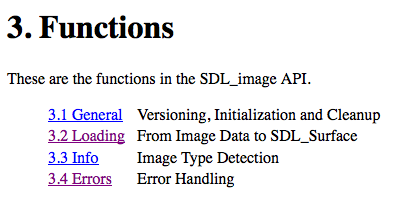在 SDL2 中貼圖
jaiyalas
Mar/16/2016
前言
Simple DirectMedia Layer
SDL, is a library designed to provide low level access to audio, keyboard, mouse, joystick, and graphics hardware via OpenGL and Direct3D.
Surface
is used in software rendering
using regular RAM to store image data
using CPU
Texture
is used in hardware rendering
using regular VRAM to store image data
using GPU (internally, using OpenGL)
有兩套 haskell bindings to SDL 2 library,
關於讀圖, sdl2 只提供了
SDL_Surface* SDL_LoadBMP(const char* file)也就是說,我們基本上只有
loadBMP :: MonadIO m => FilePath -> m Surface我的問題
- 我不想要(只能)用 BMP 呀!
- 我不想要(只能)用 Surface 呀!
我的計畫
- Plan A 找人家寫好的 Library
- Plan B 自己讀圖, 自己畫
A 計畫
SDL_image 2.0 (C library)
SDL-image (Haskell package)
- depends on that SDL
JuixyPixel (Haskell package)
自己的格式:
Image沒人寫過 JuixyPixel -> sdl2 (至少我沒找到過)
放棄!!
B 計畫
-
JiuscyPixel, sdl2, cairo 和 sdl2-cairo
ill-designed and ill-implemented (buggy + slow)
sdl2-image
low/high-level binding to SDL_image (C library)
今天第一個題目
使用 sdl2, sdl2-cairo, cairo 和 JuicyPixels
來讀/繪圖的崩潰歷程
先來整理一下各套件是怎麼儲存圖片的..
JuicyPixels
import qualified Data.Vector.Storable as V
data Image a = Image
{ imageWidth :: {-# UNPACK #-} !Int
, imageHeight :: {-# UNPACK #-} !Int
, imageData :: V.Vector (PixelBaseComponent a)}e.g. V.Vector PixelRGBA8 or V.Vector PixelCMYK16
SDL2 (Texture)
newtype Texture =
Texture Raw.Texture deriving (Eq, Typeable)
type Texture = Ptr ().....(默)
SDL2 (Surface)
import qualified Data.Vector.Storable.Mutable as MSV
data Surface = Surface
(Ptr Raw.Surface) (Maybe (MSV.IOVector Word8))
data Surface = Surface
{ ...
, surfacePixels :: !(Ptr ())
, ...} deriving (Eq, Show, Typeable)MSV.IOVector Word8?surfacePixels :: !(Ptr ())?
放棄 Vector-to-Vector 暴力硬塞法
我自己一個像素一個像素畫總行了吧?! (ㄋ羞)
在 sdl2 裡面繪圖要用 Renderer
搞不清楚 Renderer, Surface, Texture 仨之間的關係
聽說 SDL.Cairo.Canvas 比較方便繪圖
改用 sdl2-cairo
Canvas 可以...
data Canvas a = ...Instances
Functor Canvas
Applicative Canvas
Monad Canvas
MonadIO Canvas... = do
background $ gray 102
fill $ red 255 !@ 128
noStroke
rect $ D 200 200 100 100
...但是
wrapper around the Cairo
Rendermonad, providing a Processing-style API.
那我何必呢? 直接用 Cairo 的 Render 就好啦~ orz
乾脆兩種都做:
class Pixel px => RenderablePixel px where
drawPx :: (V2 Int, px) -> Canvas ()
class Pixel px => RenderablePixelC px where
renderPx :: (V2 Int, px) -> Render ()Then..
- lots of bug..
- Vector-to-Vector
- rendering with
Renderer
今天第二個題目
我自己寫!
+--- Image.hs
|--- Image
+--- General.hs
|--- Info.hs
|--- Loading.hs
|--- Raw.hs
|--- Raw
+--- General.hs
|--- Info.hs
|--- Loading.hs
|--- Enum.hscStep 1
設定 cabal (以 sdl2-image 為例)
includes:
SDL_image.h
extra-libraries:
SDL2_image
pkgconfig-depends:
SDL2_image >= 2.0.0Step 2
- 建立 .hsc 檔案來描述 Haskell 對 C 介面
- .hsc 裡面支援很多指令來直接和 C 做溝通
#include#const#type
- 可以都用來描述 常數 和 結構 等等
- 通常塞在檔案結構的很裡面(
.../Raw/下面)
範例: 常數
module SDL.Image.Raw.Enum where
--
#include "SDL_image.h"
--
pattern IMG_INIT_JPG = (#const IMG_INIT_JPG) :: CInt
pattern IMG_INIT_PNG = (#const IMG_INIT_PNG) :: CInt
pattern IMG_INIT_TIF = (#const IMG_INIT_TIF) :: CInt範例: 常數 (compiled)
module SDL.Image.Raw.Enum where
--
{-# LINE 13 "src/SDL/Image/Raw/Enum.hsc" #-}
--
pattern IMG_INIT_JPG = (1) :: CInt
{-# LINE 19 "src/SDL/Image/Raw/Enum.hsc" #-}
pattern IMG_INIT_PNG = (2) :: CInt
{-# LINE 20 "src/SDL/Image/Raw/Enum.hsc" #-}
pattern IMG_INIT_TIF = (4) :: CInt
{-# LINE 21 "src/SDL/Image/Raw/Enum.hsc" #-}範例: 簡單結構
type Texture = Ptr ()
type InitFlag = Word32
type Keycode = (#type SDL_Keycode)範例: 複雜結構
data Color = Color !Word8 !Word8 !Word8 !Word8
deriving (Eq, Show, Typeable)
instance Storable Color where
sizeOf _ = (#size SDL_Color)
peek ptr = do
r <- (#peek SDL_Color, r) ptr
g <- (#peek SDL_Color, g) ptr
b <- (#peek SDL_Color, b) ptr
a <- (#peek SDL_Color, a) ptr
return $! Color r g b aStep 3
- 把 C 的 module 變成
../Raw/xxx.hs

|--- Raw
+--- General.hs
|--- Info.hs
|--- Loading.hs
|--- Enum.hsclow-level binding
foreign import ccall注意 function type!
SDL_Surface *IMG_LoadTyped_RW( SDL_RWops *src
, int freesrc
, char *type)foreign import ccall "SDL_image.h IMG_LoadTyped_RW"
imgLoadRWTyped_FFI :: Ptr RowType.RWops
-> CInt
-> CString
-> IO (Ptr RowType.Surface)less-low-level binding
可以根據情況再稍微多包一點點
讓 type 更有意義一點
imgLoadRWTyped :: MonadIO m => Ptr RowType.RWops
-> Bool
-> CString
-> m (Ptr RowType.Surface)
imgLoadRWTyped p autoFree typeStr = liftIO $
imgLoadRWTyped_FFI p (fromBool autoFree) typeStr
{-# INLINE imgLoadRWTyped #-}Step 4
- 設計好用的 data structures 和 type-classes
- low-level to high-level, e.g.
imgLoadRWTyped :: MonadIO m => Ptr SDL.Row.RWops
-> Bool
-> CString
-> m (Ptr SDL.Row.Surface)surfaceFromImgT :: MonadIO m => ImageType -> Image -> m SDL.SurfaceThen..
- so far so good
- 效能不明
- 還沒上到 hackage
- 連結 sdl2-image(github)
- 參考連結 sdl2